Ijraset Journal For Research in Applied Science and Engineering Technology
- Home / Ijraset
- On This Page
- Abstract
- Introduction
- Conclusion
- References
- Copyright
A Review on Smart Shopping Trolley with Mobile Cart Application
Authors: Fiza Mariam, Prof. Gowrishankar B S, Niharika Nandi S P, B S Ganavi
DOI Link: https://doi.org/10.22214/ijraset.2022.40793
Certificate: View Certificate
Abstract
The modern technology has increased the standard of living for the human. Everyone craves for a quality in everything in our daily lives. Today in the current global scenario the modern technology has increased the standard of living for the human. Demands have been emerged for quick and easy payment of bills in shopping malls. The experience of shopping at a shopping mall is often frustrating because shoppers have to look for items with minimal assistance available. To overcome these problems self-directed smart cart is a solution implemented using RFID Technology.
Introduction
I. INTRODUCTION
In this world of IOT (Internet of Things) carrying out tasks have become a lot more convenient with the best efficiency. There is many research of IOT on different applications. We can say that one of the biggest applications of IOT will be smart shopping systems which aim at making the shopping experience fast with easy checking out. Once the item is put into the cart it is automatically scanned and as the customer shops a real-time bill is generated. The store shelves continuously monitor the status of items and reports it to a central server also the same can be reported to the staff as well. This enables inventory management with batch processing. With the adoption of RFID and IOT technologies, such a smart shopping system is only a few steps from becoming true. In current technology customer needs to physically purchase the products, need to search for product, carry cash or card along with them and wait in long queue for making payment. The application which has been designed would read the product id of the product assigned in the RFID and add it to the cart in the application. Whenever the customer puts a product into trolley it will get scanned by RFID reader and product price, RFID tag ID number and total cost of the products will be displayed on the screen. The quantity of the items to be purchased can be changed easily. Then the smart is capable of routing itself to the location of the product. Every purchased products price is to be read by the RFID reader on the Smart-Cart through RFID tag on the product. Concurrent billing and calculation will be done by the website developed. When the shopping is completed, the amount gets debited from the customer’s prepaid account. This will save time that was earlier being consumed to scan each item.
II. LITERATURE SURVEY
A. Smart Shopping Cart
In [4] this paper the author has designed a unique system for shopping mall in which the system is attached to shopping cart. The system includes a RFID tag also each product has RFID tag. The billing process is automatically carried out in the trolley itself. The product details such as the product name and product price are displayed on the LCD display. The payment of bill amount is done at the cash counter.
B. Innovative Shopping Cart
In [5] this paper the author has designed a smart way for shopping. This system is developed for a shopping mall in which a RFID tag is replaced by a barcode scanner. The components of this smart trolly includes a RFID reader, LCD screen and Zigbee transmitter. As each product is added to the cart it sums up in the total bill at the end this is stored in the microcontroller memory. The only drawback in this system is the distance barrier which is due to Zigbee.
C. Smart Trolley using Arduino
In [6], this paper the author invented a system consisting of components like ARM7, RFID, Display, Switch, IR Sensor pair, Power supply, Barcode reader Visual Basics. The system used both barcode reader and RFID as well. The shopping process is carried out by implementing the concept of serial communication where the bill is sent to the billing counter and then a hardcopy of the same is generated. The advantage is that the customers can pay through cards or other modes of payment. The main drawback of this system is that the system becomes more multifaceted by the use of both RFID and barcode reader.
D. RFID Based Advanced Shopping trolley for Super Market
In [7], this paper the author invented a system consisting of various components like RFID, GSM, OTP, Automatic billing, PIC and Zigbee. In this system, the shopping item can be read by the reader and the total cost of the products is displayed on the LCD Screen.
This paper was characterized because many additional features like the displaying of product name and price on the display screen and also the ringing of alarm when item weight is mismatched.
E. Smart Trolley with Smart Billing
In [8] this paper the author developed such a system which included a smart trolley and also smart billing. Additional functionality was included where the system calculated and updated the customer bill every time a new product was added into the cart.
Also, after the shopping process is completed, the customer has to press a key, on pressing this key the billing counter displayed the number of items in the customer trolley on the LCD screen after which the billing has to be done. An updated new bill is generated only when a product is removed from the trolley [9].
Drawbacks: It is a tedious task to attach RFID tag to some products [10]. The other drawback in this system is the distance barrier which is due to Zigbee.
F. RFID-Cloud smart cart system
In this paper RFID was used for billing purpose along with other components like PCB, Wi-Fi, and a power supply to intend the shopping cart [11].
Providing a centralized and automatic billing system this smart trolley system is estimated that it will be capable of bill generation from the shopping trolley itself.
III. CHALLENGES OF PRESENT SYSTEM
It is a time-consuming process to scan details of each n every item.
- Customers try to estimate the bill total manually before the actual billing takes place.
- Customers have to wait for a long time in queues to get the billing process done.
- Barcode scanners need a clear vision of the barcode to scan with efficiency.
- To read the barcode the barcode scanner must be rather near to it but its shouldn’t be more than 10ft.
- Barcodes don’t have the feature of read/write capability.
- While customers have to wait for some time the barcode scanner retrieves the product information.
- Every single product must be scanned physically which is a time consuming and hectic process.
IV. PROPOSED METHDOLOGY
The smart shopping system consists of trolleys that are incorporated with RFID readers and in all the commodities present in the shopping complex a RFID card is separately attached that has distinctive RFID number. The moment at which customer places a product they want to buy in the smart trolley, RFID card number of that product is identified by the RFID read which is attached to smart cart.
Each product is linked with its unique RFID card number. The entire information regarding the RFID card and its associated product is stored in a database. This database can be retrieved using a centralized server. The Raspberry Pi Controller is responsible for coordination of all the activities. Each customer is given a membership card. When the customer swipes the membership card, all his login information is displayed on the web application.
The application is dynamically updated as and when the customer places the bought commodities into the cart. The informative details of the commodity are flashed on the screen attached to the trolley. When the customer finishes shopping, he/she has to swipe the membership card again and the server calculates the total bill which would be displayed on the web application. There is flexibility in the mode of payment i.e., the customer can either pay online or even through mobile wallet. After the payment of the bill, the database is updated and the user can leave the store. At the exit gate, the RFID reader and an IR sensor checks the bill for confirming that no non billed product is taken by the customer.
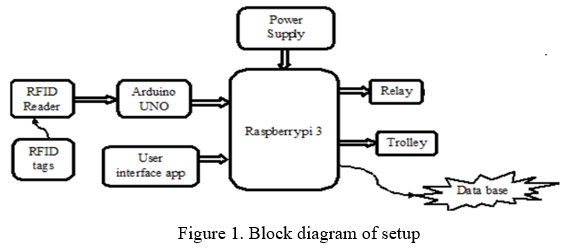
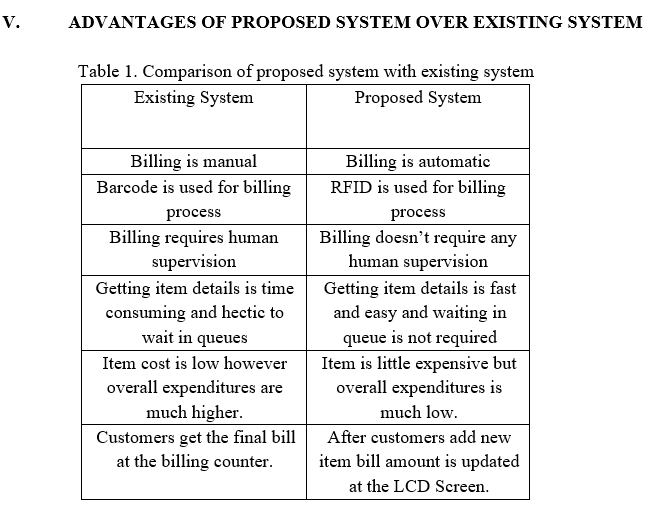

A. Proposed Architecture Flow
- Step 1: Every new customer gets a unique RFID card by paying the prepaid amount and sign-up.
- Step 2: The Registered customer can initiate the shopping by tapping the RFID card on the RFID reader in the Smart-cart.
- Step 3: The choice to choose between previously purchased history list and new list with the available wallet balance.
- Step 4: The customer can choose the required product list available in the supermarket.
- Step 5: Every product scanned by the customer gets displayed onscreen with its weight, quantity and price.
- Step 6: When the RFID Card reads by the RFID reader the total bill amount gets deducted from the customer’s prepaid balance.
VI. FLOWCHART OF PROPOSED SYSTEM
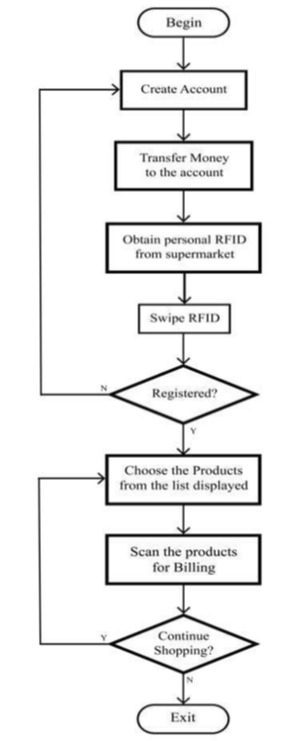
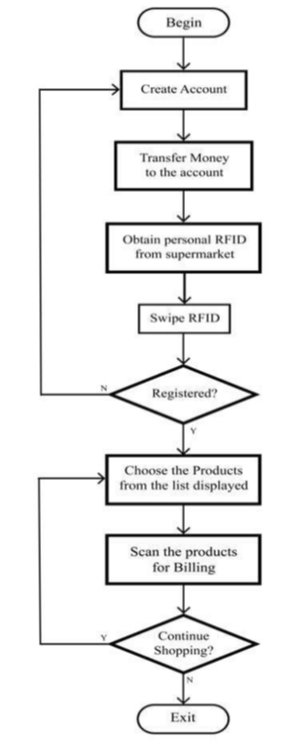
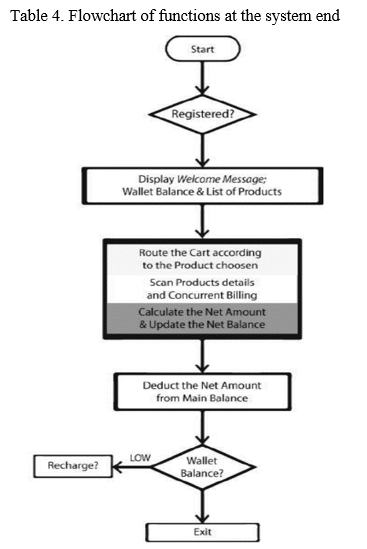
VII. HARDWARE AND SOFTWARE REQUIREMENTS
A. Hardware Requirements
- Raspberry Pi 4 Model B
- Arduino UNO
- RFID tag
- RFID reader
- Relay
- Power Supply
B. Software Requirements
- Database
- Programming languages: Python 3
- Android App
Conclusion
This article is composed after reviewing multiple papers on smart shopping systems. To sum up it can be stated that the shopping experience can be made easy and fast with the use of such smart shopping systems consisting of different controllers. The controllers used can prove to make the systems system bulky on which further research can be carried out. To overcome this issue of bulkiness we can be smart in choosing an ideal controller. Hence, we can say that using Raspberry Pi the shopping systems size can be convenient for shoppers. Also, it will be easy to interface as there is no requirement to add an extra module to interface RFID and the other system components. Using python makes the execution process easier with more efficiency, shorter length of code which is easy to understand and implement.
References
[1] Machike K, Golait M, Rathod R, Petkar R, Goche P. (2017). A new technology of smart trolley using RFID and ZIGBEE. International Journal on Recent and Innovation Trends in Computing and Communication 5(2): 256-259. [2] Thiyagarajan M, Aejaz M, Kumar M. (2017). RFID based advanced trolley for super market. Special Issue 8. [3] Prasad JS, Kumar BOP, Roopa D, Arjun AK. (2011). A novel low-cost intelligent shopping cart. IEEE 2nd International Conference on Networked Embedded Systems for Enterprise Applications, pp. 1-4. [4] Karpagam V, Balapriya S, Kalairubini G, Kalaivani A. (2017). Smart trolley with smart billing. |International Journal of Computer Systems 4(3): 55-58. [5] Gade A, Bhatt N, Thakare N. (2018). Survey on energy efficient cloud: A novel approach towards green computing. Helix 5(5): 3976-3979. https://doi.org/10.29042/2018-3976-3979 [6] Chandrasekar P, Sangeetha T. (2014). Smart shopping cart with automatic billing system through RFID and Zigbee. Information Communication and Embedded Systems (ICICES 2014), pp. 1–4. https://doi.org/10.1109/ICICES.2014.7033996 [7] Ms. Rupali Sawant, Kripa Krishnan, Shweta Bhokre, Priyanka Bhosale (2015). The RFID based smart shopping cart. International Journal of Engineering Research and General Science 3(2): 275-280. [8] Dawkhar K, Dhomase S, Mahabaleshwarkar S. (2015). Electronic shopping cart for effective shopping based on RFID. International Journal of Innovative Research in Electrical, Electronic, Instrumentation and Control Engineering 3(1): 84-86. https://doi.org/10.17148/IJIREEICE.2015.3117 [9] Ambekar K, Dhole V, Sharma S, Wadekar T. (2015). Smart shopping trolley using RFID. International Journal of Advanced Research in Computer Engineering & Technology (IJARCET) 4(10): 3875-3877. [10] Shelke CJ, Karde P, Thakre VM. (2015). Study of various perspectives of android security. International Journal of Innovative Research in Computer and Communication Engineering 3(10): 9667-9672. https://doi.org/10.15680/IJIRCCE.2015. 0310116 [11] Balaji S, Balamuruguan S, Marimuthu R. (2017). Smart shopping cart. IEEE Internet of Things Journal. [12] Bedi H, Goyal N, Kumar S, Gupta A. (2017). Smart trolley using Smart phone and Arduino. Journal of Electrical & Electronic Systems 2(12): 6. https://doi.org/10.4172/2332-0796.1000223 [13] Thiyagarajan M, Aejaz M, Kumar M. (2017). RFID based advanced shopping trolley for super market. Research Gate Journal 8. [14] Berdaliyev Y, James AP. (2016). Smart shopping cart using Zigbee department of electrical and electronic engineering school of engineering. Nazarbayev University Astana, Kazakhstan. [15] Saad SS, Nakad ZS. (2011). A standalone RFID indoor positioning system using passive tags. IEEE Transactions on Industrial Electronics 58(5): 1961-1970. https://doi.org/10.1109/TIE.2010.2055774 [16] Chandra Babu DVS. (2012). Wireless intelligent billing trolley for supermarket. International Journal of Advanced Research in Technology 3(1). [17] Yewatkara A, Inamdarb F, Singh R, Bandale AA. (2018). Smart billing trolley via application. International Journal of Advance Research in Engineering, Science & Technology 5(3). [18] Larsan Aro Brian A, Arockiam L, Sheba Kezia Malarchelvi PD. (2014). An IOT based secured smart library system with NFC based book tracking. International Journal of Emerging Technology in Computer Science & Electronics (IJETCSE) 11(5): 1821. [19] Priyanka S. Sahare, Anup Gade, Jayant Rohankar (2019). A Review on Automated Billing for Smart Shopping System Using IOT. review of computer engineering studies. https://doi.org/10.18280/rces.06010.
Copyright
Copyright © 2022 Fiza Mariam, Prof. Gowrishankar B S, Niharika Nandi S P, B S Ganavi. This is an open access article distributed under the Creative Commons Attribution License, which permits unrestricted use, distribution, and reproduction in any medium, provided the original work is properly cited.

Download Paper
Paper Id : IJRASET40793
Publish Date : 2022-03-15
ISSN : 2321-9653
Publisher Name : IJRASET
DOI Link : Click Here
 Submit Paper Online
Submit Paper Online

